Space Shuttle Columbia
| Columbia OV-102 | |
|---|---|
 Columbia preparing for launch for STS-109 to repair the Hubble Space telescope. This was the final successful mission of Columbia before STS-107. | |
| OV designation | OV-102 |
| Country | United States |
| Contract award | July 26, 1972 |
| Named after | Columbia (1773) |
| Status | Destroyed February 1, 2003 |
| First flight |
STS-1 April 12, 1981 – April 14, 1981 |
| Last flight |
STS-107 January 16, 2003 – February 1, 2003 |
| No. of missions | 28 |
| Crew members | 160 |
| Time spent in space | 300 days 17:40:22[1] |
| No. of orbits | 4,808 |
| Distance travelled | 201,497,772 km (125,204,911 miles) |
| Satellites deployed | 8 |
Space Shuttle Columbia (Orbiter Vehicle Designation: OV-102) was the first space-rated orbiter in NASA's Space Shuttle fleet. It launched for the first time on mission STS-1 on April 12, 1981, the first flight of the Space Shuttle program. Over 22 years of service it completed 27 missions before disintegrating during re-entry near the end of its 28th mission, STS-107 on February 1, 2003, resulting in the deaths of all seven crew members.
History
Construction began on Columbia in 1975 at Rockwell International's (formerly North American Aviation/North American Rockwell) principal assembly facility in Palmdale, California, a suburb of Los Angeles. Columbia was named after the American sloop Columbia Rediviva which, from 1787 to 1793, under the command of Captain Robert Gray, explored the US Pacific Northwest and became the first American vessel to circumnavigate the globe. It is also named after the Command Module of Apollo 11, the first manned landing on another celestial body.[2] Columbia was also the female symbol of the United States. After construction, the orbiter arrived at Kennedy Space Center on March 25, 1979, to prepare for its first launch. Columbia was originally scheduled to lift off in late 1979, however the launch date was delayed by problems with both the SSME components, as well as the thermal protection system (TPS).[3] On March 19, 1981, during preparations for a ground test, workers were asphyxiated while working in Columbia's nitrogen-purged aft engine compartment, resulting in (variously reported) two or three fatalities.[4][5]

The first flight of Columbia (STS-1) was commanded by John Young, a veteran from the Gemini and Apollo programs who was the ninth person to walk on the Moon in 1972, and piloted by Robert Crippen, a rookie astronaut originally selected to fly on the military's Manned Orbital Laboratory (MOL) spacecraft, but transferred to NASA after its cancellation, and served as a support crew member for the Skylab and Apollo-Soyuz missions.
Columbia spent 610 days in the Orbiter Processing Facility (OPF), another 35 days in the Vehicle Assembly Building (VAB), and 105 days on Pad 39A before finally lifting off.[3] Columbia was successfully launched on April 12, 1981, the 20th anniversary of the first human spaceflight (Vostok 1), and returned on April 14, 1981, after orbiting the Earth 36 times, landing on the dry lakebed runway at Edwards Air Force Base in California. Columbia then undertook three further research missions to test its technical characteristics and performance. Its first operational mission, with a four-man crew, was STS-5, which launched on November 11, 1982. At this point Columbia was joined by Challenger, which flew the next three shuttle missions, while Columbia underwent modifications for the first Spacelab mission.

In 1983, Columbia, under the command of John Young on what was his sixth spaceflight, undertook its second operational mission (STS-9), in which the Spacelab science laboratory and a six-person crew was carried, including the first non-American astronaut on a space shuttle, Ulf Merbold. After the flight, Columbia spent 18 months at the Rockwell Palmdale facility beginning in January 1984, undergoing modifications that removed the Orbiter Flight Test hardware and bringing it up to similar specifications as those of its sister orbiters. At that time the shuttle fleet was expanded to include Discovery and Atlantis.
Columbia returned to space on January 12, 1986, with the launch of STS-61-C. The mission's crew included Dr. Franklin Chang-Diaz, as well as the first sitting member of the House of Representatives to venture into space, Bill Nelson.
The next shuttle mission, STS-51-L, was undertaken by Challenger. It was launched on January 28, 1986, ten days after STS-61-C had landed, and ended in disaster 73 seconds after launch. In the aftermath NASA's shuttle timetable was disrupted, and Columbia was not flown again until 1989 (on STS-28), after which it resumed normal service as part of the shuttle fleet.
STS-93, launched on July 23, 1999, was the first U.S. space mission with a female commander, Lt. Col. Eileen Collins. This mission deployed the Chandra X-ray Observatory.
Columbia's final successful mission was STS-109, the fourth servicing mission for the Hubble Space Telescope. Its next mission, STS-107, culminated in the orbiter's loss when it disintegrated during reentry, killing all seven of its crew.
Consequently, President Bush decided to retire the Shuttle orbiter fleet by 2010 in favor of the Constellation program and its manned Orion spacecraft. The Constellation program was later cancelled with the NASA Authorization Act of 2010 signed by President Obama on October 11.
Construction milestones
| Date | Milestone[7] |
|---|---|
| July 26, 1972 | Contract Awarded to North American Rockwell |
| March 25, 1975 | Start long lead fabrication aft fuselage |
| November 17, 1975 | Start long-lead fabrication of crew module |
| June 28, 1976 | Start assembly of crew module |
| September 13, 1976 | Start structural assembly of aft-fuselage |
| December 13, 1977 | Start assembly upper forward fuselage |
| January 3, 1977 | Start assembly vertical stabilizer |
| August 26, 1977 | Wings arrive at Palmdale from Grumman |
| October 28, 1977 | Lower forward fuselage on dock, Palmdale |
| November 7, 1977 | Start of Final Assembly |
| February 24, 1978 | Body flap on dock, Palmdale |
| April 28, 1978 | Forward payload bay doors on dock, Palmdale |
| May 26, 1978 | Upper forward fuselage mate |
| July 7, 1978 | Complete mate forward and aft payload bay doors |
| September 11, 1978 | Complete forward RCS |
| February 3, 1979 | Complete combined systems test, Palmdale |
| February 16, 1979 | Airlock on dock, Palmdale |
| March 5, 1979 | Complete postcheckout |
| March 8, 1979 | Closeout inspection, Final Acceptance Palmdale |
| March 8, 1979 | Rollout from Palmdale to Dryden |
| March 12, 1979 | Overland transport from Palmdale to Edwards |
| March 20, 1979 | SCA Ferry Flight from DFRC to Biggs AFB, Texas |
| March 22, 1979 | SCA Ferry flight from Biggs AFB to Kelly AFB, Texas |
| March 24, 1979 | SCA Ferry flight from Kelly AFB to Eglin AFB, Florida |
| March 24, 1979 | SCA Ferry flight from Eglin, AFB to KSC |
| November 3, 1979 | Auxiliary Power Unit hot fire tests, OPF KSC |
| December 16, 1979 | Orbiter integrated test start, KSC |
| January 14, 1980 | Orbiter integrated test complete, KSC |
| February 20, 1981 | Flight Readiness Firing |
| April 12, 1981 | First Flight (STS-1) |
Prototype orbiter

Weight
As the second orbiter to be constructed, and the first able to fly into space, Columbia was roughly 8,000 lb (3,600 kg) heavier than subsequent orbiters such as Endeavour, which were of a slightly different design, and had benefited from advances in materials technology.[8] In part, this was due to heavier wing and fuselage spars, the weight of early test instrumentation that remained fitted to the avionics suite, and an internal airlock that, originally fitted into the other orbiters, was later removed in favor of an external airlock to facilitate Shuttle/Mir and Shuttle/International Space Station dockings.[9] Due to its weight, Columbia could not have used the planned Centaur-G booster (cancelled after the loss of Challenger).[10] The retention of the internal airlock allowed NASA to use Columbia for the STS-109 Hubble Space Telescope servicing mission, along with the Spacehab double module used on STS-107. Due to Columbia's heavier weight, it was less ideal for NASA to use it for missions to the International Space Station, though modifications were made to the Shuttle during its last refit in case the spacecraft was needed for such tasks.
Thermal protection system
Externally, Columbia was the first orbiter in the fleet whose surface was mostly covered with High & Low Temperature Reusable Surface Insulation (HRSI/LRSI) tiles as its main thermal protection system (TPS), with white silicone rubber-painted Nomex – known as Felt Reusable Surface Insulation (FRSI) blankets – in some areas on the wings, fuselage and payload bay doors. FRSI once covered almost 25% of the orbiter; the first upgrade resulted in its removal from many areas, and in later flights it was only used on the upper section of the payload bay doors and inboard sections of the upper wing surfaces.[11] The upgrade also involved replacing many of the white LRSI tiles on the upper surfaces with Advanced Flexible Reusable Surface Insulation (AFRSI) blankets (also known as Fibrous Insulation Blankets, or FIBs) that had been used on Discovery and Atlantis. Originally, Columbia had 32,000 tiles – the upgrade reduced this to 24,300. The AFRSI blankets consisted of layers of pure silica felt sandwiched between a layer of silica fabric on the outside and S-Glass fabric on the inside, stitched together using pure silica thread in a 1-inch grid, then coated with a high-purity silica coating. The blankets were semi-rigid and could be made as large as 30" by 30". Each blanket replaced as many as 25 tiles and was bonded directly to the orbiter.[11] The direct application of the blankets to the orbiter resulted in weight reduction, improved durability, reduced fabrication and installation cost, and reduced installation schedule time.[12] All of this work was performed during Columbia's first retrofitting and the post-Challenger stand-down.

Despite refinements to the orbiter's thermal protection system and other enhancements, Columbia would never weigh as little unloaded as the other orbiters in the fleet. The next-oldest shuttle, Challenger, was also relatively heavy, although 2,200 lb (1,000 kg) lighter than Columbia.
Markings and insignia
Until its last refit, Columbia was the only operational orbiter with wing markings consisting of an American flag on the port (left) wing and the letters "USA" on the starboard (right) wing. Challenger, Discovery, Atlantis and Endeavour all, until 1998, bore markings consisting of the letters "USA" below an American flag on the left wing, and the pre-1998 NASA "worm" logo afore the respective orbiter's name on the right wing. (Enterprise, the test vehicle which was the prototype for Columbia, originally had the same wing markings as Columbia but with the letters "USA" on the right wing spaced closer together; Enterprise's markings were modified to match Challenger in 1983.) The name of the orbiter was originally placed on the payload bay doors much like Enterprise but was placed on the crew cabin after the Challenger disaster so that the orbiter could be easily identified while in orbit. From its last refit to its destruction, Columbia bore markings identical to those of its operational sister orbiters – the NASA "meatball" logo on the left wing and the American flag afore the orbiter's name on the right; only Columbia's distinctive wing "chines" remained. These black areas on the upper surfaces of the shuttle's forward wing were added because, at first, shuttle designers did not know how reentry heating would affect the craft's upper wing surfaces. The "chines" allowed Columbia to be easily recognized at a distance, as opposed to the subsequent orbiters. The "chines" were added after Columbia arrived at KSC in 1979.
SILTS pod
Another unique external feature, termed the "SILTS" pod, was located on the top of Columbia's vertical stabilizer, and was installed after STS-9 to acquire infrared and other thermal data. Though the pod's equipment was removed after initial tests, NASA decided to leave it in place, mainly to save costs, along with the agency's plans to use it for future experiments. The vertical stabilizer was later modified to incorporate the drag chute first used on Endeavour in 1992.
Other upgrades

Columbia was also originally fitted with Lockheed-built ejection seats identical to those found on the SR-71 Blackbird. These were active for the four orbital test flights, but deactivated after STS-4, and removed entirely after STS-9. Columbia was also the only spaceworthy orbiter not delivered with head-up displays for the Commander and Pilot, although these were incorporated after STS-9. Like its sister ships, Columbia was eventually retrofitted with the new MEDS "glass cockpit" display and lightweight seats.
Future

Had Columbia not been destroyed, it would have been fitted with the external airlock/docking adapter for STS-118, an International Space Station assembly mission, originally planned for November 2003. Columbia was scheduled for this mission due to Discovery being out of service for its Orbital Maintenance Down Period, and because the ISS assembly schedule could not be adhered to with only Endeavour and Atlantis.
Columbia’s 'career' would have started to wind down after STS-118. It was to service the Hubble Space Telescope two more times between 2004 and 2005, but no more missions were planned for it again except for a mission designated STS-144 where it would retrieve the Hubble Space Telescope from orbit and bring it back to Earth. Following the Columbia accident, NASA flew the STS-125 mission using Atlantis, combining the planned fourth and fifth servicing missions into one final mission to Hubble. Because of the retirement of the Space Shuttle fleet, the batteries and gyroscopes that keep the telescope pointed will eventually fail also because of the magnifier screen, which would result in its reentry and break-up in Earth's atmosphere. A "Soft Capture Docking Mechanism", based on the docking adapter that was to be used on the Orion spacecraft, was installed during the last servicing mission in anticipation of this event.
Columbia was also scheduled to launch the X-38 V-201 Crew Return Vehicle prototype as the next mission after STS-118, until the cancellation of the project in 2002.
Flights
Columbia flew 28 missions, gathering 300.74 days spent in space with 4,808 orbits and a total distance of 125,204,911 miles (201,497,772 km) up until STS-107.
Despite being in service during the Shuttle-Mir and International Space Station programs, Columbia did not fly any missions that visited a space station. The other three active orbiters at the time had visited both Mir and the ISS at least once. Columbia was not suited for high-inclination missions.
| # | Date | Designation | Launch pad | Landing location | Notes |
|---|---|---|---|---|---|
| 1 | 1981, April 12 | STS-1 | 39-A | Edwards Air Force Base | First shuttle mission. |
| 2 | 1981, November 12 | STS-2 | 39-A | Edwards Air Force Base | First re-use of manned space vehicle |
| 3 | 1982, March 22 | STS-3 | 39-A | White Sands Space Harbor | First mission with an unpainted External tank. Only time a space shuttle landed at the White Sands Space Harbor. |
| 4 | 1982, June 27 | STS-4 | 39-A | Edwards Air Force Base | Last shuttle R&D flight |
| 5 | 1982, November 11 | STS-5 | 39-A | Edwards Air Force Base | First four-person crew, first deployment of commercial satellite. |
| 6 | 1983 November 28 | STS-9 | 39-A | Edwards Air Force Base | First six-person crew, first Spacelab. |
| 7 | 1986, January 12 | STS-61-C | 39-A | Edwards Air Force Base | Representative Bill Nelson (D-FL) on board/ final successful shuttle flight before the Challenger disaster |
| 8 | 1989, August 8 | STS-28 | 39-B | Edwards Air Force Base | Launched KH-11 reconnaissance satellite |
| 9 | 1990, January 9 | STS-32 | 39-A | Edwards Air Force Base | Retrieved Long Duration Exposure Facility |
| 10 | 1990, December 2 | STS-35 | 39-B | Edwards Air Force Base | Carried multiple X-ray & UV telescopes |
| 11 | 1991, June 5 | STS-40 | 39-B | Edwards Air Force Base | 5th Spacelab – Life Sciences-1 |
| 12 | 1992, June 25 | STS-50 | 39-A | Kennedy Space Center (due to Hurricane Darby) | U.S. Microgravity Laboratory 1 (USML-1) |
| 13 | 1992, October 22 | STS-52 | 39-B | Kennedy Space Center | Deployed Laser Geodynamic Satellite II |
| 14 | 1993, April 26 | STS-55 | 39-A | Edwards Air Force Base | German Spacelab D-2 Microgravity Research |
| 15 | 1993, October 18 | STS-58 | 39-B | Edwards Air Force Base | Spacelab Life Sciences |
| 16 | 1994, March 4 | STS-62 | 39-B | Kennedy Space Center | United States Microgravity Payload-2 (USMP-2) |
| 17 | 1994, July 8 | STS-65 | 39-A | Kennedy Space Center | International Microgravity Laboratory (IML-2) |
| 18 | 1995, October 20 | STS-73 | 39-B | Kennedy Space Center | United States Microgravity Laboratory (USML-2) |
| 19 | 1996, February 22 | STS-75 | 39-B | Kennedy Space Center | Tethered Satellite System Reflight (TSS-1R) |
| 20 | 1996, June 20 | STS-78 | 39-B | Kennedy Space Center | Life and Microgravity Spacelab (LMS) |
| 21 | 1996, November 19 | STS-80 | 39-B | Kennedy Space Center | 3rd flight of Wake Shield Facility (WSF)/ longest Shuttle flight |
| 22 | 1997, April 4 | STS-83 | 39-A | Kennedy Space Center | Microgravity Science Laboratory (MSL)- cut short |
| 23 | 1997, July 1 | STS-94 | 39-A | Kennedy Space Center | Microgravity Science Laboratory (MSL)- reflight |
| 24 | 1997, November 19 | STS-87 | 39-B | Kennedy Space Center | United States Microgravity Payload (USMP-4) |
| 25 | 1998, April 13 | STS-90 | 39-B | Kennedy Space Center | Neurolab – Spacelab |
| 26 | 1999, July 23 | STS-93 | 39-B | Kennedy Space Center | Deployed Chandra X-ray Observatory |
| 27 | 2002, March 1 | STS-109 | 39-A | Kennedy Space Center | Hubble Space Telescope service mission (HSM-3B) |
| 28 | 2003, January 16 | STS-107 | 39-A | Did not land (Planned to land at Kennedy Space Center) | A multi-disciplinary microgravity and Earth science research mission. Shuttle destroyed during re-entry on February 1, 2003 and all seven astronauts on board killed. |
Mission insignia
| Mission insignia for Columbia flights | |||||||
|---|---|---|---|---|---|---|---|
 |
 |
 |
 |
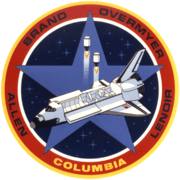 |
 |
 |
 |
| |
|
|
|
|
|
|
|
 |
 |
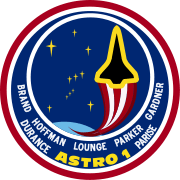 |
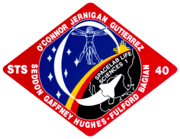 |
 |
 |
 |
 |
| |
|
|
|
|
|
|
|
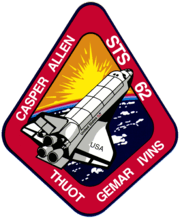 |
 |
 |
 |
 |
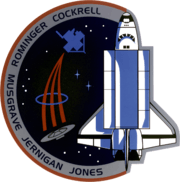 |
 |
 |
| |
|
|
|
|
|
|
|
 |
 |
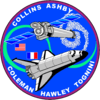 |
 |
 |
 |
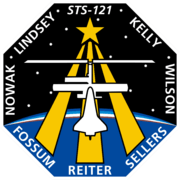 | |
| |
|
|
|
|
|
| |
Final mission and destruction
Columbia was destroyed at about 09:00 EST on February 1, 2003 while re-entering the atmosphere after a 16-day scientific mission. The Columbia Accident Investigation Board determined that a hole was punctured in the leading edge on one of Columbia's wings, made of a carbon composite. The hole had formed when a piece of insulating foam from the external fuel tank peeled off during the launch 16 days earlier and struck the shuttle's left wing. During the intense heat of re-entry, hot gases penetrated the interior of the wing, likely compromising the hydraulic system and leading to control failure of the aerosurfaces. The resulting loss of control exposed minimally protected areas of the orbiter to full-entry heating and dynamic pressures that eventually led to vehicle break up.[13] The nearly 84,000 pieces of collected debris of the vessel are stored in a 16th floor office suite in the Vehicle Assembly Building at the Kennedy Space Center. The collection was opened to the media once and has since been open only to researchers.[14][15] Unlike Challenger, which had a replacement orbiter built, Columbia did not.
The seven crew members who died aboard this final mission were: Rick Husband, Commander; William C. McCool, Pilot; Michael P. Anderson, Payload Commander/Mission Specialist 3; David M. Brown, Mission Specialist 1; Kalpana Chawla, Mission Specialist 2; Laurel Clark, Mission Specialist 4; and Ilan Ramon, Payload Specialist 1.[16]
Tributes and memorials
- Patricia Huffman Smith Museum
The debris field encompassed hundreds of miles across Northeast Texas and into Louisiana. The nose cap and remains of all seven crew members were found in Sabine County, East Texas.
To honor those who lost their lives aboard the shuttle and during the recovery efforts, the Patricia Huffman Smith NASA Museum "Remembering Columbia" was opened in Hemphill, Sabine County, Texas. The museum tells the story of Space Shuttle Columbia explorations throughout all its missions, including the final STS-107. Its exhibits also show the efforts of local citizens during the recovery period of the Columbia shuttle debris and its crew's remains. An area is dedicated to each STS-107 crew member, and also to the Texas Forest Service helicopter pilot who died in the recovery effort. The museum houses many objects and artifacts from: NASA and its contractors; the families of the STS-107 crew; and other individuals. The crew's families contributed personal items of the crew members to be on permanent display. The museum features two interactive simulator displays that emulate activities of the shuttle and orbiter. The digital learning center and its classroom provide educational opportunities for all ages.[17]
- Columbia Memorial Space Center
The Columbia Memorial Space Center is the U.S. national memorial for the Space Shuttle Columbia’s seven crew members. It is located in Downey on the site of the Space Shuttle's origins and production, the former North American Aviation plant in Los Angeles County, southern California. The facility is also a hands-on learning center with interactive exhibits, workshops, and classes about space science, astronautics, and the Space Shuttle program's legacy — providing educational opportunities for all ages.[18]
- Naming dedications
The shuttle's final crew was honored in 2003 when the United States Board on Geographic Names approved the name Columbia Point for a 13,980-foot (4,260 m) mountain in Colorado's Sangre de Cristo Mountains, less than a half-mile from Challenger Point, a peak named after America's other lost shuttle. The Columbia Hills on Mars were also named in honor of the crew, and a host of other memorials were dedicated in various forms.
The Columbia supercomputer at the NASA Advanced Supercomputing (NAS) Division located at Ames Research Center in California was named in honor of the crew lost in the 2003 disaster. Built as a joint effort between NASA and technical partners SGI and Intel in 2004, the supercomputer was used in scientific research of space, the Earth's climate, and aerodynamic design of space launch vehicles and aircraft.[19] The first part of the system, built in 2003, was dedicated to STS-107 astronaut and engineer Kalpana Chawla, who prior to joining the Space Shuttle program worked at Ames Research Center.[20]
Media tributes
Guitarist Steve Morse of the rock band Deep Purple wrote the instrumental "Contact Lost" in response to the news of the tragedy, recorded by Deep Purple and featured as the closing track on their 2003 album "Bananas". It was dedicated to the astronauts whose lives were lost in the disaster. Morse donated songwriting royalties to the families of lost astronauts.[21] Astronaut and mission specialist engineer Kalpana Chawla, one of the victims of the accident, was a fan of Deep Purple and had exchanged e-mails with the band during the flight, making the tragedy even more personal for the group.[21] She took three CDs into space with her, two of which were Deep Purple albums (Machine Head and Purpendicular). Both CDs survived the destruction of the shuttle and the 39-mile plunge.[22]
The musical group Echo's Children included singer-songwriter Cat Faber's "Columbia" on their final album From the Hazel Tree.[23]
The Long Winters band's 2005 album Ultimatum features the song "The Commander Thinks Aloud", a tribute to the final Columbia crew.[24]
The Eric Johnson instrumental "Columbia" from his 2005 album Bloom was written as a commemoration and tribute to the lives that were lost. Johnson said "I wanted to make it more of a positive message, a salute, a celebration rather than just concentrating on a few moments of tragedy, but instead the bigger picture of these brave people’s lives."[25]
The graphic novel Orbiter by Warren Ellis and Colleen Doran was dedicated to the "lives, memories and legacies of the seven astronauts lost on space shuttle Columbia during mission STS-107."
Laurel Clark’s wake up call on STS – 107 was Runrig’s "Running to the Light". Laurel took The Stamping Ground CD into space with her and when the Shuttle exploded the CD was found back on Earth, and presented to the band. The bands last Studio Album, The Story, final track, "Somewhere", ends with a recording of her voice introducing the song.
Popular culture
- Fans of the original Star Trek television series were largely responsible for NASA naming the first Space Shuttle Enterprise. In the television series Star Trek: Enterprise both the first and second starships of the human-built NX-Class, registry numbers NX-01 & NX-02 respectively, were named in honor of pre-existing NASA Space Shuttles. The second vessel's name was first revealed in the season 3 episode "E²" to be Columbia, in honor of the Space Shuttle Columbia following its destruction on February 1, 2003. The uniforms on NX-02 Columbia bear a crew patch depicting 7 stars, in honor of the astronauts who died in the accident.
- In Pokémon Red and Blue and Pokémon Yellow a model of the Space Shuttle can be seen on the second floor of the Pewter City Museum. While Columbia was identified by name in the original games, in the 2004 remakes Pokémon FireRed and LeafGreen, the model was simply identified as "Space Shuttle". The 2016 release for 3DS did not censor the name.
- A restored Columbia was used in episode 19 ("Wild Horses") of the anime Cowboy Bebop to rescue Spike when his Swordfish enters a steep orbit and is going to burn up. After the rescue, the shuttle crash-lands after losing heat-resistant tiles. The anime, made in 1998, predated the Columbia disaster by five years.[26]
- The beginning of Kate Bush's song Hello Earth, from the Hounds of Love album, samples signals to and from Columbia during a re-entry during the early 1980s.
- Homer Hickam's novel Back to the Moon is mostly set on Columbia. The structural differences between Columbia and the other shuttles is central to the plot.
- In the finale of the first season of The West Wing, "What Kind of Day Has It Been", Columbia does not land on schedule due to technical problems with a door mechanism. Toby Ziegler's brother is on board. The shuttle lands successfully by the end of the episode.
- The rock band Rush wrote and recorded the song "Countdown" about the launch of STS-1. All three members of the group were present at the launch, and the credits of the album Signals dedicated the song to "the astronauts Young & Crippen and all the people of NASA for their inspiration and cooperation."
- The shuttle features in opening chapters of the 1997 Stephen Baxter novel 'Titan', where it is portrayed carrying out mission STS-143.
- Crew members from Mission STS-73 (Ken Bowersox, Catherine G. Coleman, Kathryn C. Thornton, Frederick W. Leslie, and Albert Sacco) were featured in the Home Improvement television show in the episode "Fear of Flying" as well as scenes from the shuttle mission.
See also
- List of Space Shuttle crews
- List of space shuttle missions
- Timeline of Space Shuttle missions
- List of spaceflight-related accidents and incidents
- List of human spaceflights
References
- ↑ Harwood, William (October 12, 2009). "STS-129/ISS-ULF3 Quick-Look Data" (PDF). CBS News. Retrieved November 30, 2009.
- ↑ "Shuttle Orbiter Columbia (OV-102)". science.ksc.nasa.gov. NASA. February 1, 2003. Retrieved July 21, 2017.
- 1 2 Slovinac, Patricia; Deming, Joan. "Avionics Systems Laboratory/Building 16. Historical Documentation". NASA Technical Reports Server. NASA. Retrieved October 18, 2011.
- ↑ "March 19, 1981: Shuttle Columbia's First Fatalities". Wired News. March 19, 2009. Retrieved July 29, 2009.
- ↑ "Space shuttle worker dies in fall at launch pad". MSNBC. March 14, 2011. Retrieved August 2, 2011.
- ↑ Chris Gebhardt (February 1, 2011). "Space Shuttle Columbia: A New Beginning and Vision". www.nasaspaceflight.com.
- ↑ "Shuttle Orbiter Columbia (OV-102)". NASA/KSC. Retrieved November 7, 2012.
- ↑ "Orbiter Overhaul: The Columbia weight loss plan". Spaceflight Now. April 14, 2000. Retrieved July 17, 2009.
- ↑ "Orbiter Overhaul: Flying into the future". Spaceflight Now. April 14, 2000. Retrieved July 17, 2009.
- ↑ Lardas, Mark (2012). Space Shuttle Launch System: 1972-2004. Osprey Publishing. p. 35.
- 1 2 "Orbiter Thermal Protection System (PDF)" (PDF). NASA's Kennedy Space Center Public Affairs Office. 2006. Retrieved June 7, 2011.
- ↑ "Advanced Flexible Reusable Surface Insulation Blankets". NASA. April 7, 2002. Retrieved June 7, 2011.
- ↑ "Columbia Crew Survival Investigation Report" (PDF). nasa.gov. National Aeronautics and Space Administration. 30 December 2008. Retrieved 31 March 2016.
- ↑ "Shuttle Columbia's wreckage finds final resting place". The New York Times. February 8, 2004. Retrieved May 2, 2010.
- ↑ "Columbia's Arlington". Collect Space. February 1, 2004.
- ↑ Nasa.gov: Columbia Crew Profiles website . Retrieved July 23, 2012.
- ↑ Patricia Huffman Smith Museum website — in Hemphill, Sabine County, Texas.
- ↑ Official Columbia Memorial Space Center website — in Downey, Los Angeles County, Southern California . Retrieved August 3, 2014
- ↑ "NASA - NASA Unveils Its Newest, Most Powerful Supercomputer". nasa.gov.
- ↑ John Hardman. "NASA to Name Supercomputer After Columbia Astronaut". nasa.gov.
- 1 2 "Deep Purple's Shuttle Connection". guitarsite.com. Archived from the original on February 15, 2007. Retrieved February 15, 2007.
- ↑ Tom Johnson. "Down To Earth – Deep Purple CDs survived Columbia tragedy". Blogcritics.
- ↑ "Columbia". echoschildren.org.
- ↑ Dan Benjamin and 5by5 Productions, LLC. "5by5 - Back to Work #31: You Can Polish AC/DC All Day Long". 5by5.tv.
- ↑ "Eric Johnson’s NASA Tone". premierguitar.com.
- ↑ "ghostlightning" (March 14, 2012). "How to Do Nostalgia in a Badass Way: Cowboy Bebop 19 'Wild Horses'" (blog). We Remember Love. WordPress. Retrieved January 27, 2012.
![]() This article incorporates public domain material from websites or documents of the National Aeronautics and Space Administration.
This article incorporates public domain material from websites or documents of the National Aeronautics and Space Administration.
External links
| Wikimedia Commons has media related to Space Shuttle Columbia. |
- Last interview of Columbia crew and memorial service with eulogy by singer Patti LaBelle (Google Video)
- Maiden launch of Columbia (Google Video)
- Columbia accident investigation board
- Columbia Crew Survival Investigation Report
- Columbia Loss FAQ at the Wayback Machine (archived July 27, 2010), compiled by members of usenet newsgroups sci.space.history and sci.space.shuttle, including some employees of NASA and their respective contractor agencies. Much of the FAQ content has been copied and used by many of the news services without credit given, including Florida Today and Space.com.
- Space.com Columbia FAQ.
- Shuttle Orbiter Columbia (OV-102)
- New York Times coverage of the shuttle
- Space Mirror Memorial
- Mission Summary Archive
- Columbia accident in the Newseum archive of front page images from 2003-02-02.
- Space Shuttle Memorial covering both space shuttle disasters






